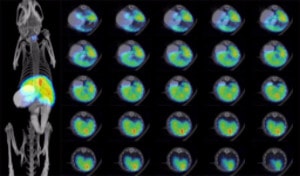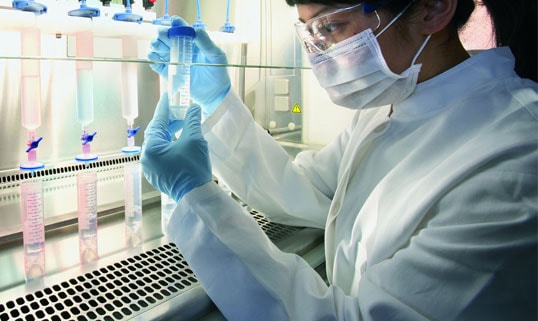A549-hNIS-Neo
- Frozen / Standard (CL004-STAN) $ 1,500
Species: Human
Cell type: Lung carcinoma
Transgenes: Human sodium iodide symporter (hNIS), neomycin resistance (Neo) for selection with G418
Media: DMEM, 10% FBS, 1% Pen/Strep, 0.6 mg/mL G418
Description: A549-hNIS-Neo is a polyclonal population of the human lung carcinoma cell line A549 (ATCC® CCL-185™) transduced with LV-hNIS-Neo (LV013) encoding the human sodium iodide symporter (hNIS) cDNA under the spleen focus-forming virus (SFFV) promoter linked to the neomycin resistance gene via an IRES.
The lentiviral vector used is a self-inactivating (SIN) vector in which the viral enhancer and promoter has been deleted. Transcription inactivation of the LTR in the SIN provirus increases biosafety by preventing mobilization by replication competent viruses and enables regulated expression of the genes from the internal promoters without cis-acting effects of the LTR (Miyoshi et al., J Virol. 1998).
Cell Line Authentication: The parental A549 cell line was authenticated and certified free of interspecies cross-contamination by short tandem repeat (STR) profiling with 9 STR loci including CSF1PO, D13S317, D16S539, D5S818, D7S820, TH01, TPOX, vWA and sex chromosome marker Amelogenin.
Recommended uses:
In vitro: This is a high hNIS expressing clone suitable for use as a positive control cell line in I-125 uptake assays to validate NIS expression in your lentiviral transduced cells.
In vivo: A549 cells form metastases in the lungs of mice post systemic administration. The in vivo growth of these metastases can be monitored noninvasively in animals using SPECT or PET imaging.
Morphology: Low and high density cell morphology (200x)
 Transgene Validation:
Transgene Validation:
NIS Functional Assay (Iodine Uptake): Cells were incubated with I-125 for 1h in the presence or absence of KClO4, an inhibitor of NIS-mediated iodine uptake. Radioiodine concentrated within the cells was measured with a gamma counter.

References on NIS imaging:
1. Fruthwirth et al. A whole body dual modality radionuclide optical strategy for preclinical imaging of metastasis and heterogeneous treatment responses in different. microenvironments. J. Nucl. Med 2014. 55(4): 686-94.
2. Penheiter et al. The sodium iodide symporter (NIS) as an imaging reporter for gene, viral and cell-based therapies. Curr Gene Ther. 2012, 12(1):33-47.

